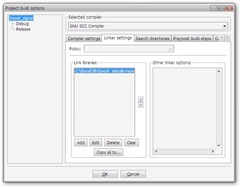Serious problem
[vnl_quaterion]
I made a mistake when coding with quaterion related sections!!
the paper format [R X Y Z]
vnl coding format [X Y Z R]
damn!!!
That means I have to compare the version between vnl_quaterion and VW::QUATERION
[vnl_matrix_fixed] "fill" member related
The source of the problem is that VXL uses explicit instantiation of Templates as opposed to ITK that uses implicit instatiation. This means that in vnl you can only use types that have already been explicity instantiated in the library. If you need to use a new combination, then
you have to add the corresponding explicit instantiation. The vnl_fixed_matrix is only instantiated for a
certain number of template parameters. You will find them under: Insight/Utilities/vxl/core/vnl/Templates They are
vnl_matrix_fixed+double.1.1-.cxx
vnl_matrix_fixed+double.1.2-.cxx
vnl_matrix_fixed+double.1.3-.cxx
vnl_matrix_fixed+double.2.1-.cxx
vnl_matrix_fixed+double.2.2-.cxx
vnl_matrix_fixed+double.2.3-.cxx
vnl_matrix_fixed+double.2.4-.cxx
vnl_matrix_fixed+double.2.6-.cxx
vnl_matrix_fixed+double.3.1-.cxx
vnl_matrix_fixed+double.3.2-.cxx
vnl_matrix_fixed+double.3.3-.cxx
vnl_matrix_fixed+double.3.4-.cxx
vnl_matrix_fixed+double.3.5-.cxx
vnl_matrix_fixed+double.4.1-.cxx
vnl_matrix_fixed+double.4.2-.cxx
vnl_matrix_fixed+double.4.3-.cxx
vnl_matrix_fixed+double.4.4-.cxx
vnl_matrix_fixed+double.6.6-.cxx
vnl_matrix_fixed+float.1.2-.cxx
vnl_matrix_fixed+float.1.3-.cxx
vnl_matrix_fixed+float.2.1-.cxx
vnl_matrix_fixed+float.2.2-.cxx
vnl_matrix_fixed+float.3.1-.cxx
vnl_matrix_fixed+float.3.3-.cxx
vnl_matrix_fixed+float.3.4-.cxx
vnl_matrix_fixed+float.3.5-.cxx
vnl_matrix_fixed+float.4.3-.cxx
vnl_matrix_fixed+float.4.4-.cxx
vnl_matrix_fixed+int.2.2-.cxx
vnl_matrix_fixed+int.3.4-.cxx
vnl_matrix_fixed+vnl_bignum.3.3-.cxx
vnl_matrix_fixed+vnl_rational.3.3-.cxx
vnl_matrix_fixed_pairwise_ops.cxx
vnl_matrix_fixed_ref+double.3.3-.cxx
vnl_matrix_fixed_ref+double.3.4-.cxx
vnl_matrix_fixed_ref+float.3.3-.cxx
vnl_matrix_fixed_ref+float.3.4-.cxx
As you can see, there is no instantiation for a matrix of size over 6 x 6 which is what you seems to be trying to instantiate.



